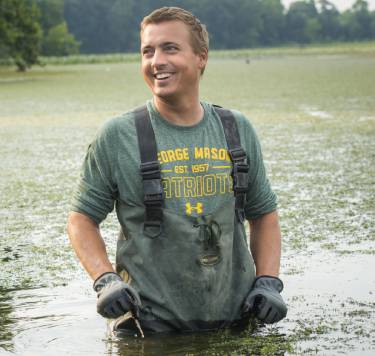
Celso Ferreira, an associate professor in the Sid and Reva Dewberry Department of Civil, Environmental, and Infrastructure Engineering, is working with fellow researchers to investigate ways to shore up the stormwater infrastructure in Northern Virginia to protect the region against flooding in the future. Photo by Evan Cantwell

Civil engineering associate professor Viviana Maggioni is looking at how the precipitation is going to change in the next 30 to 50 years and what parts of the area are vulnerable to flooding.
Mason Engineering researchers are studying ways to shore up the stormwater infrastructure in Northern Virginia to protect the region against flooding in the future.
The area is growing fast in terms of urbanization and population, and it’s near the Potomac River and the Chesapeake Bay, which makes it vulnerable to flooding, says civil engineering associate professor Viviana Maggioni.
“We are looking at how the precipitation is going to change in the next 30 to 50 years and what parts of the area are vulnerable to flooding,” she says.
Stormwater infrastructure is critical for carrying water through an urban area during extreme precipitation events. It includes curbs, gutters, drains, piping, and collection systems such as basins and reservoirs.
“The designs for those systems are usually based on historical climate conditions, but we can’t just rely on the past to design stormwater infrastructure anymore because climate variability may be affecting the desired performance of this infrastructure in the future,” says Celso Ferreira, an associate professor in the Sid and Reva Dewberry Department of Civil, Environmental, and Infrastructure Engineering (CEIE).
“We are developing insights to help decision-makers build resilient stormwater infrastructure that is still safe under future conditions,” he says.
Maggioni and Ferreira and two of their PhD students, as well as several other Mason researchers and regional experts, got involved in the American Geophysical Union (AGU) Thriving Earth Exchange project, initiated by the Northern Virginia Regional Commission (NVRC), which wanted to collaborate with local scientists to better understand regional vulnerability scenarios to flooding.
.jpg)
PhD student Gustavo Coelho uses hydrologic models to evaluate stormwater infrastructure.

Civil engineering PhD student Ishrat Jahan Dollan is analyzing precipitation data.
For their part of the project, Maggioni and her PhD student Ishrat Jahan Dollan are analyzing precipitation data. They are looking at precipitation patterns to determine if the intensity and frequency of storms in the region have been changing over time.
“Precipitation is the driving force and the main cause of floods, and by correctly characterizing rainfall, we can predict such extreme events,” Maggioni says.
Dollan says, “My contribution to this project is to provide reliable, detailed precipitation estimates at a one-kilometer resolution that will be used as input to generate flooding scenarios.”
Then, Ferreira and PhD student Gustavo Coelho will use their hydrologic models to evaluate the stormwater infrastructure and create flood maps and compare them with the flood maps they currently have.
“We will take the precipitation data to determine how the stormwater infrastructure needs to be adapted so the region can become more resilient to flooding,” Coelho says.
“We will think about multiple solutions—stormwater systems, basins, and channels—and advise the planners and engineers on how they can make the region more prepared to mitigate flooding impacts,” he says.
Researchers and local planners are collaborating to advance scientific knowledge into decision-making tools, Dollan says.
The next generation of engineers will need to design stormwater infrastructure that is resilient under future and yet unknown conditions but is still cost-effective with current resources, Ferreira says. “This interdisciplinary project is exploring how to do just that.”
